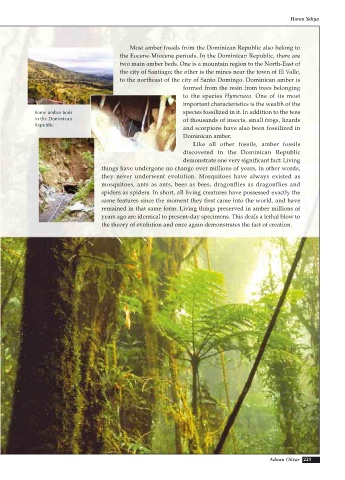Page 223 - Atlas of Creation Volume 1
P. 223
Harun Yahya
Most amber fossils from the Dominican Republic also belong to
the Eocene-Miocene periods. In the Dominican Republic, there are
two main amber beds. One is a mountain region to the North-East of
the city of Santiago; the other is the mines near the town of El Valle,
to the northeast of the city of Santo Domingo. Dominican amber is
formed from the resin from trees belonging
to the species Hymenaea. One of its most
important characteristics is the wealth of the
Some amber beds species fossilized in it. In addition to the tens
in the Dominican of thousands of insects, small frogs, lizards
Republic
and scorpions have also been fossilized in
Dominican amber.
Like all other fossils, amber fossils
discovered in the Dominican Republic
demonstrate one very significant fact: Living
things have undergone no change over millions of years, in other words,
they never underwent evolution. Mosquitoes have always existed as
mosquitoes, ants as ants, bees as bees, dragonflies as dragonflies and
spiders as spiders. In short, all living creatures have possessed exactly the
same features since the moment they first came into the world, and have
remained in that same form. Living things preserved in amber millions of
years ago are identical to present-day specimens. This deals a lethal blow to
the theory of evolution and once again demonstrates the fact of creation.
Adnan Oktar 221

